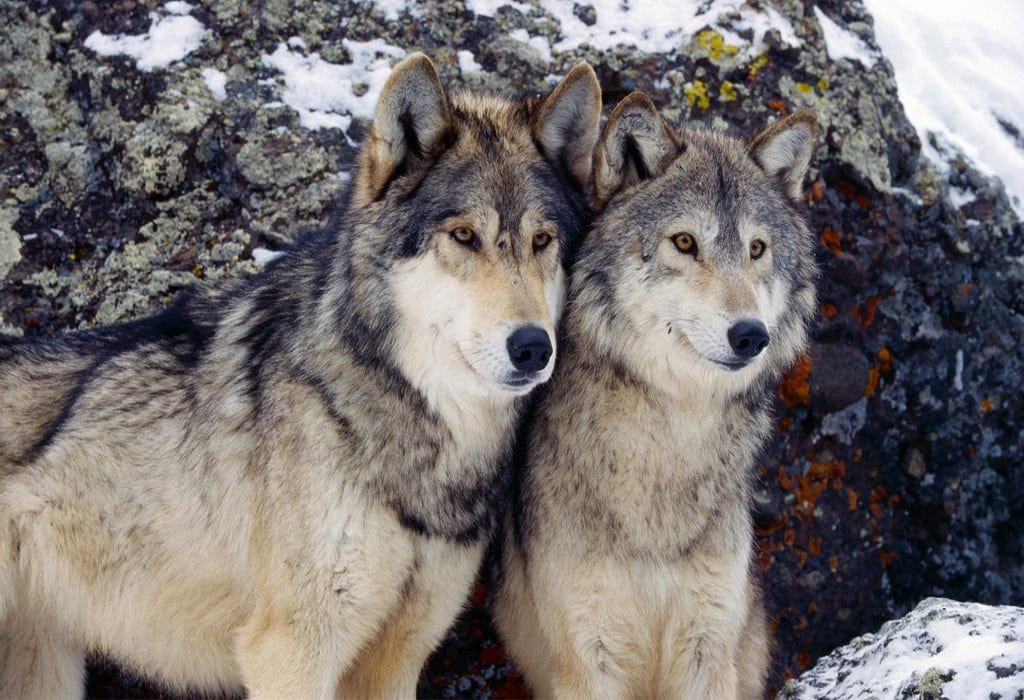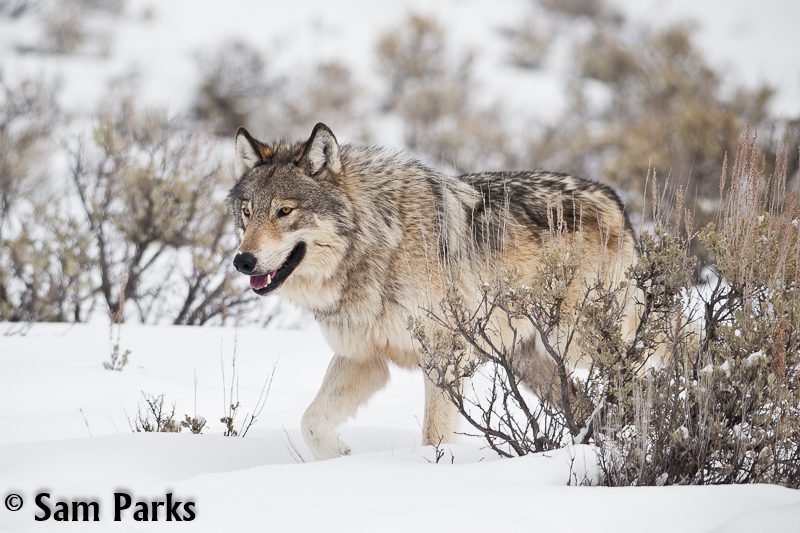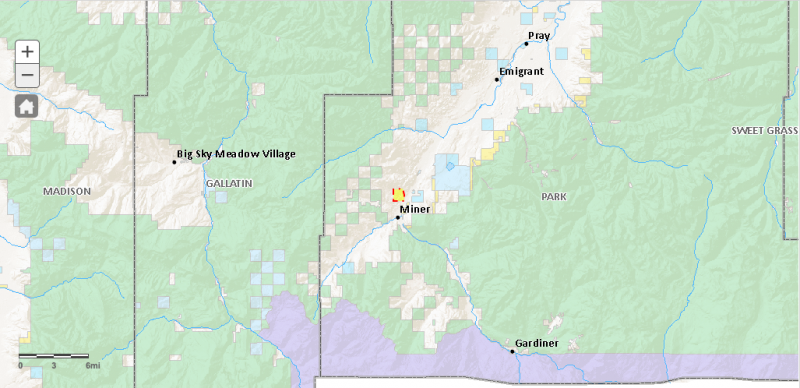
Ryan Devereaux
Martha Williams is at a crossroads. As director of U.S. Fish and Wildlife Service, the agency responsible for enforcing the Endangered Species Act, Williams is arguably the most important official in Washington for saving wildlife amid the ongoing mass extinction crisis. Last year, her agency announced a review to determine whether wolves in the Northern Rockies should regain federal protection under the landmark statute after Montana and Idaho launched the most aggressive wolf hunts in recent history.
The circumstances would be delicate for any director. While the presence of wolves has been a battle in the West’s culture war for generations, the fight has taken on an intensity unlike anything the region has seen since the animals were first reintroduced there in the 1990s. For Williams, the assessment has added significance requiring her to delve into her own past as the head of Montana’s game agency.
Williams’s review is probing the conduct, regulations, and science of a department she once led and shaped, in a state she still calls home. As a top attorney and later as a director, Williams’s career is defined by her years in Montana’s Fish, Wildlife and Parks, better known as FWP. Across a decade and half of service, Williams earned respect on both sides of the wolf wars and helped craft a legal framework for protecting the state’s most political animal. Now a top federal official, Williams’s supporters are pulling her in divergent directions, while critics are questioning her credentials and calling on her to step down entirely.
Last year’s changes in wolf hunting and trapping regulations were felt particularly hard in Yellowstone National Park, which weathered its deadliest season in living memory. With a new Montana wolf hunting season underway and park researchers studying the unprecedented levels of human-caused mortality, the deadline for the federal government’s review has now passed, and environmental groups have filed suit demanding that Williams take action.
Two policy decisions from Williams’s Montana years are central to the assessments she is making in her Endangered Species Act review. The first has to do with how wolf populations in the region are estimated. The second is the unique category that wolves occupy under Montana law: Originally designed as a protection during Williams’s years as an FWP attorney, the special category paradoxically made wolves more vulnerable to controversial hunting techniques following her tenure as FWP director.
“What Montana has done is they basically turned that regulatory mechanism on its head, and they are now using it effectively as a threat to wolves, not as a protection,” Dan MacNulty, associate professor of wildland resources at Utah State University, told me. “That’s very concerning, and I think it should concern the Fish and Wildlife Service in terms of whether or not Montana is living up to the commitment it made with respect to that delisting rule.”
Fish and Wildlife Service announced the review of a petition to relist wolves in the Northern Rockies in September 2021, eight months after Williams had become the agency’s acting leader. The review followed dramatic regional changes in state hunting and trapping regulations. Under pressure from environmental organizations to appoint a confirmed leader at FWS, President Joe Biden nominated Williams the following month. The nomination was celebrated by both environmental groups and an array of hunting interests. Sen. Jon Tester, a Montana Democrat, and Sen. Steve Daines, a Montana Republican, both urged their colleagues to vote for confirmation.
Dave Parsons, a retired wildlife biologist who led the FWS reintroduction of wolves in the Southwest in the 1990s, was one of the few voices of public dissent. For nearly a year, Parsons, along with Bob Aland, a retired attorney and environmental activist, have been waging a two-man campaign to remove Williams from the position. The reason, they argue, is that she is unqualified under the law. Federal statute requires that the director of FWS have “scientific education and experience” and be knowledgeable in “the principles of fisheries and wildlife management.”
While Williams’s experience is undeniable, her educational background is in philosophy and law, not science. “My primary concern on the surface is not her as an individual,” Parsons told me. “My interest is saving the agency from this now dark path, where the precedent has been set that you can put in a person without biological credentials in violation of the law.”
The issue has come up before. In 2018, Greg Sheehan stepped down as principal deputy director of FWS under President Donald Trump after then-Interior Secretary Ryan Zinke sought to have him take full leadership of the agency. Zinke’s effort failed due to Sheehan’s lack of a science degree. How Williams navigated the requirement is unclear. (FWS declined to make the director available for an interview or to comment on the appointment.)
In December, Parsons wrote an op-ed describing how every FWS director going back to the Nixon administration had met the scientific education requirement. “I’m trying to save my old agency, for crying out loud,” he said. “Try to imagine Trump Act II and that law just thrown under the rug.”
In the weeks leading up to Williams’s confirmation hearing, he and Aland informed aides on Capitol Hill that Williams lacked a scientific background. They contacted the White House, the Department of the Interior, and FWS.
When Williams appeared before lawmakers in November, the issue never came up. She was confirmed in a bipartisan 16-to-4 vote in February.

U.S. Fish and Wildlife Service Director Martha Williams speaking at a hearing of the Senate Environment and Public Works committee, in Washington, D.C., in November 2021.
Photo: Michael Brochstein/Sipa via AP Images
Williams’s confirmation
was the culmination of a long career enmeshed in the legal wrangling surrounding wolves and the Endangered Species Act.
Wolves were reintroduced to Yellowstone National Park and central Idaho under the law in 1995, after a government extermination campaign led to their near-total extirpation decades before. Williams joined Montana’s game agency three years later and, over the next decade and a half, represented the state in its delisting efforts.
Under the terms laid out by FWS, wolves in the Northern Rockies — Montana, Idaho, and Wyoming — would be considered recovered once there were 30 breeding pairs raising at least two pups each for three consecutive years. In 2002, the agency announced that the criteria had been met. Before the transfer of management authority could happen, however, the states needed to prove that they had a regulatory framework in place to support continued wolf recovery.

The first wolf arrives at Yellowstone National Park in a pen carried by, from left, Mike Phillips, Yellowstone Wolf Project leader; Jim Evanoff, Yellowstone environmental protection specialist; Molly Beattie, U.S. Fish and Wildlife Service director; Mike Finley, Yellowstone superintendent; and Bruce Babbitt, secretary of the interior, in January 1995. Photo: Jim Peaco/NPS
In Montana, the solution Williams and her colleagues came up with was to categorize wolves as a “species in need of management.” The special designation had surfaced a year before, in a bill passed by the Montana Senate, which aimed to carve out a space for wolves once they were removed from the state’s endangered species list.
Categories are key to wildlife governance. Generally, “game” animals, like elk or deer, can be hunted but not trapped, while “furbearers,” like otters or bobcats, can be trapped but not hunted. In many states, “predators,” like coyotes, can be killed anytime, anywhere without a license or a defined season. In a 2003 environmental impact statement that Williams consulted on, Montana made the case that wolves would stand apart as a “species in need of management,” receiving “full protection” as a non-game animal. Once wolves were recovered, the state’s game commissioners would decide which of Montana’s more conventional categories fit the animals best.
In 2009, the Obama administration announced the delisting of wolves in Montana and Idaho, but not Wyoming, which continually failed to come up with a plan that didn’t involve treating the animals as predators that could be shot on sight. “Montana did an outstanding job of describing, in detail, its regulatory framework and its commitment to wolf management,” FWS noted in its rule.
The delisting was immediately challenged and in 2010 struck down by a federal judge.
Williams was recruited to her first Interior Department stint the following year. She had once again joined a government agency facing a historic moment for wolves. That same year, Tester, the Democratic senator from Montana, attached a rider to a federal budget bill that reversed the court’s decision to reject delisting and prohibited any other judge from undoing the reversal. The move was unprecedented and political: Tester was up for reelection in one of the most important races of 2012, facing an opponent who claimed that he was out of touch with rural voters on the wolf issue.

Sen. Jon Tester, D-Mont., walks through the Capitol building in Washington, D.C., on Aug. 6, 2022.
Photo: Ting Shen/Bloomberg via Getty Images
Tester won the race, and wolves have been off the Endangered Species List in Montana ever since. Williams returned to her home state as a law professor at the University of Montana soon after. In 2017, she was nominated by then-Montana Gov. Steve Bullock to serve as director of Montana’s FWP, the first woman in the position.
Williams created a review committee in 2018 to study whether the array of hunting and trapping regulations that FWP produced each year were in line with state law. She also presided over the implementation of a new model for estimating wolf populations in the state. Both efforts would play key roles in the wolf review she is now overseeing as director of the nation’s most important wildlife agency.
Aimee Hawkaluk was a staff attorney at FWP from 2012 until January of this year. She served on the committee that Williams convened to review regulations. Speaking in a personal capacity and not as a representative of her former or current employer, Hawkaluk said the committee ultimately determined that years of wolf hunting and trapping regulations in Montana misrepresented the law, and that the problem related to the “species in need of management” categorization developed in the early 2000s.
The original idea was that wolves would have a higher degree of protection until they were recovered, at which point they would be reclassified as a furbearer or game animal. “That’s never happened,” Hawkaluk told me, “so they’re just kind of stuck in limbo as a species in need of management.”
The upshot was significant. Following the 2009 delisting, FWP issued regulations each year explaining to hunters and trappers what they could and could not do in pursuit of wolves. Among the prohibitions were the use of aircraft and radio telemetry equipment — the kind of gear biologists use to find and monitor wildlife. Those prohibitions, however, were effectively copied from the state’s game animal regulations. As a non-game species in need of management, wolves did not have those protections, Williams’s committee determined. In the department’s view, the warnings amounted to an ongoing, decadelong mistake.
The review committee conducted its work over two years, reaching some of the critical conclusions on the technology that could be used to hunt wolves after Williams packed up for her return to Washington in 2021. The timing was critical. Despite the many opportunities already offered under the law, Republican lawmakers and a subset of hunters and trappers had long argued that Montana’s regulations did not go far enough. They agitated for wolves to be treated as predators that could be killed with little restriction.
“I had a bill that was going to place wolves on the predator list — make them a predator, just treat them as predator,” Bob Brown, a Montana state senator, said at an FWP Committee hearing last year. But after speaking with the governor’s office, FWP, and others, he concluded it was not the right approach “because it could lead to relisting.” Instead, the senator introduced legislation to slash Montana’s wolf population by giving hunters and trappers the authority to kill an unlimited number of wolves using bait, snares, and, on private land, authority to hunt at night with bright lights and night-vision goggles.
“I think a lot of folks of whatever view on wolves are probably a bit concerned about opening the can of worms. And so here we stand.”
It was the kind of extreme proposal that normally died on the governor’s desk in Montana, but things had changed the previous fall. Voters elected Greg Gianforte as Montana’s first Republican governor in a decade and half. Gianforte stacked the most important posts in Montana’s wildlife decision-making apparatus — from Williams’s old job atop FWP to the commissioners who create policy for the department — with campaign contributors, a former running mate, and representatives of aggressively pro-wolf hunting interests. He then went on to sign Brown’s bill and a half dozen other measures targeting the state’s most iconic predator.
In response, nearly three dozen veteran Montana wildlife managers, many of them Williams’s former FWP colleagues, published an essay decrying Montana’s “anti-predator hysteria” and the “partisan political intervention that overturned decades of sound wildlife policy.”
Despite the pushback, Gianforte’s commissioners approved the most aggressive regulations in recent Montana history for last winter’s wolf hunt. At the same time, the results of Williams’s review committee came to fruition in the form of the state’s 2021 wolf regulations.
Advocacy organizations soon noticed the prohibition on aerial hunting had disappeared and called on a Montana judge to issue an injunction to stop the practice. At a court hearing in February, Hawkaluk described how Williams’s review committee concluded that wolves were not in fact protected from aerial hunting under state law. (The practice remained illegal under a federal statute, though FWP’s regulations omitted that fact.)
The original idea of a “species in need of management” had been twisted beyond recognition. Instead of bestowing protections, the designation made the animals vulnerable to a tactic used for the culling of feral hogs. “It doesn’t seem to fit what that law was created to do,” Hawkaluk told me, reiterating that she was speaking for herself.
For Hawkaluk, the trajectory of wolves within Montana’s bureaucracy reflects the contentious politics that surrounds the animals. “I think it’s just so convoluted now that it would take an overhaul to crack that, and I think a lot of folks of whatever view on wolves are probably a bit concerned about opening the can of worms,” she said. “And so here we stand.”
Aerial hunting wasn’t the only tactic to disappear from Montana’s regulations last year. Without public notice, the prohibition against using radio telemetry equipment was also gone. There is at least some evidence that hunters may have attempted to take advantage of the new opportunity.
Early one morning last February, a group of ecotourism guides gathered with their clients north of Yellowstone National Park’s boundary line. They were hoping to spot a mountain lion when a flash of unusual human activity caught their attention instead.
A man had pulled up in a pickup truck. He parked, stepped out of the vehicle, and raised above his head what looked like a radio antenna. He had neither the uniform nor the vehicle of a government official. As the truck pulled away, a third guide recognized the driver as one of the area’s most well-known proponents of aggressive wolf hunting north of Yellowstone.
The guides were concerned. By that point, hunters and trappers had killed an unprecedented 19 of the park’s wolves, many in and around the area where they now stood. The guides sent witness statements to an FWP game warden. When I visited Yellowstone in late May, word of the incident had spread among the park’s research and touring community. I interviewed the guides and reviewed their statements to FWP, then asked the department about the claims and whether hunting wolves with telemetry equipment was now legal.
“FWP game wardens looked into the report and found no functional telemetry equipment or evidence of violation,” Morgan E. Jacobsen, a spokesperson for FWP’s southwest region, said in an email in July. As for using telemetry in wolf hunts, Jacobsen added: “This would not be lawful while in the act of hunting under Montana’s statute on two-way communication.”
In the portion of Montana that abuts Yellowstone Park, the death toll of 19 wolves marked a 342 percent increase from the previous decade’s annual average of four.
The following week, The Intercept published an investigation revealing that the final Yellowstone wolf to die in last winter’s hunt was a radio-collared animal, killed by a veteran backcountry park ranger in the same gulch where the guides had seen the hunter with the antenna. The ranger told me that, following his kill, he became the subject of a National Park Service investigation in which he and other Yellowstone law enforcement officials were accused — falsely, he said — of sharing location information on collared wolves with hunters outside the park. NPS declined to comment on the claims, citing an ongoing investigation. FWP, meanwhile, said its Helena-based special investigations unit was conducting a separate investigation into the wolf’s killing.
The day before the story broke, Brian Wakeling, FWP’s game management bureau chief, wrote to the guide who had recognized the hunter and explained that hunting wolves with telemetry gear was legal in Montana — contradicting the statement his colleague gave to The Intercept just six days earlier. “The department cannot enforce laws that are not applicable and did not wish to imply that the regulation applied to wolves,” Wakeling wrote.
Ecotourism guides weren’t the only ones concerned about the issue. On July 20, the day The Intercept’s wolf investigation went live, Cam Sholly, the superintendent of Yellowstone National Park, sent a letter to Montana’s game commissioners arguing that using telemetry to hunt wolves violated the fair chase principle, which holds that human hunters do not take unfair advantage of nonhuman prey, and requested that “this prohibition be re-inserted into your regulations.”
Montana’s wolf season was over by that point. In the portion of the state that abuts Yellowstone Park — where longstanding quotas on wolf kills were eliminated entirely — the death toll of 19 wolves marked a 342 percent increase from the previous decade’s annual average of four.

Wolves at Blacktail Pond at Yellowstone National Park, in 2019.
Photo: Jim Peaco/NPS
At a Montana
House hearing last spring, Republican state Rep. Paul Fielder voiced support for Brown’s legislation to slash the state’s wolf population, pointing to a “new and improved model” for estimating those numbers, which he claimed showed an increase of approximately 300 animals.
Montana had “about” 1,164 wolves — a problem, Fielder argued, since the state’s wolf management plan referred to just 15 breeding pairs and 150 individual animals. “Basically, we have four times as many wolves in Montana as the wolf management plan calls for,” he said. “So what this bill does is it gives us some more tools to manage wolves, and we’re not talking about necessarily ethical management of them. We want to reduce wolf numbers.”
Fielder failed to note that the figures cited in the state’s management plan reflect a minimum threshold for the state’s wolf population. An official liaison between the Montana Trappers Association and FWP, the state lawmaker was in the middle of passing his own legislation expanding the “tools” — like indiscriminate neck snares — that could be employed in Montana’s not “necessarily ethical” campaign to kill hundreds of wolves.
How many wolves roam the Northern Rockies and whether state policies promote recovery are the central questions Williams’s endangered species review must consider. Few people have had as close a relationship to those questions as David Ausband.
As part of the U.S. Geological Survey’s Cooperative Fish and Wildlife Research Units Program, which partners graduate students and state fish and wildlife agencies for research and technical assistance purposes, Ausband is both a federal employee and a faculty member at the University of Idaho. Prior to taking the job in 2018, he was a senior wildlife research biologist for the Idaho Department of Fish and Game. Before that, he worked in Montana in a USGS unit focused on wolf recovery post-delisting.
In the early days, Ausband explained, monitoring wolves in the Northern Rockies was straightforward. There were fewer packs and the ones that were on the landscape usually had collared members, which made them easier to find. As time went on, things got complicated. Wolves learned to avoid the traps researchers used and, with the legalized hunting, the breakup of packs became increasingly common. “It just got harder to keep collars out,” Ausband said.
With delisting, Montana and Idaho entered a five-year period of federal supervision to ensure the states were complying with the Endangered Species Act. Ausband was among a group of officials from Idaho, Montana, and Yellowstone National Park who gathered each year to sort out which packs belonged to which jurisdictions. Though the work was tedious, it was also critical. In annual reports required under the act, the experts highlighted the existence of “border packs” — as opposed to “resident packs” — whose potential for double-counting could throw off the accuracy of population estimates. There was a lot of wrangling to figure out whose packs were whose, Ausband said, but “they were explicitly accounted for.”
During the transition to state wolf management, Montana and Idaho relied on millions of dollars from the U.S. FWS for the resource-intensive work of monitoring radio collars in the field. As the supervisory period wore on, however, the money ran dry. “It was like a slow decay,” Ausband said. He added, “The states were trying to come up with new, cheaper ways to keep monitoring their population but that wouldn’t break the bank.”
The supervised delisting period and the resources that came with it ended in 2016. Williams returned to FWP as director the following year. With end of federal supervision, the efforts to sort out border packs ended too. “Each state estimates their own population and there’s really none of those debates about border packs anymore,” Ausband said. The question is not whether wolves migrating across state and international borders are being double-counted by the states, it’s to what degree and whether the double-counting has meaningfully impacted the statistics being trotted out by lawmakers to justify extraordinarily aggressive wolf hunts.
“It’s a great question, and I honestly can’t answer it,” Ausband said. “It’s a source of bias. How big it is, I don’t know.”
In 2020, during Williams’s final year as FWP’s director, Montana began using a new system to estimate its wolf population: the “integrated patch occupancy model” — iPOM, for short. Used only in Montana and only for wolves, iPOM was the state’s answer to the problem of diminished resources, supplementing reduced radio-collar tracking with an increased reliance on hunters reporting wolf sightings in the wild.
“The problem is that they don’t know if the hunters are sighting resident packs or nonresident packs,” said MacNulty, the Utah State University researcher. For the past year, MacNulty has delved deep into the modeling system that served as the basis for politicians’ calls to make deep cuts to the wolf population. If you don’t know how many wolves there are on the land, he asked, “then how are you going to evaluate the threats to that population?”
“We can’t take wolf recovery for granted. Because the people who want to see a reduction in the wolf numbers are very serious about it.”
MacNulty is not the only one concerned. In his letter over the summer, Sholly, the Yellowstone superintendent, described a “lack of scientific data and low confidence” in Montana’s wolf-counting methodologies. Scott Creel, a large carnivore population ecologist with Montana State University, has also found problems in the state’s model, describing “considerable doubt about the accuracy of population estimates from the iPOM” in a critique published last year.
In March, Daines, the Republican senator and proud backer of last winter’s wolf hunt, urged Williams to take bold action on the Endangered Species Act — not to relist wolves but to delist grizzly bears. In August, the Center for Biological Diversity filed a lawsuit against the director for failing to meet the deadline in the wolf status review. Both Daines and the center supported Williams’s nomination, and both have vastly divergent expectations of the director now that she’s in power. Together their demands reflect the contentious state of predator politics in the Northern Rockies. At the center of that fight is the highly anticipated conclusion of Williams’s review.
For years, MacNulty believed that the region’s wolf population was secure. Right-wing politicians could push for predator-style management, but they were likely to fail. That’s no longer the case. Montana and Idaho now under legal obligation to reduce their wolf populations, and lawmakers have made clear their intent to cut those numbers to the bone.
“We can’t take wolf recovery for granted,” MacNulty said. “Because the people who want to see a reduction in the wolf numbers are very serious about it, and they’re using these flawed outputs to support their positions.”
Time will tell if Williams, another veteran of the West’s wolf wars, agrees.
https://theintercept.com/2022/09/29/wolves-endangered-species-martha-williams/























































